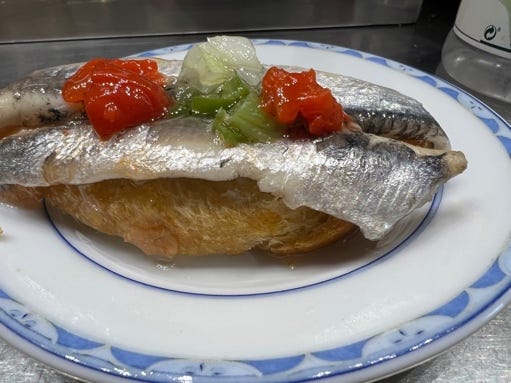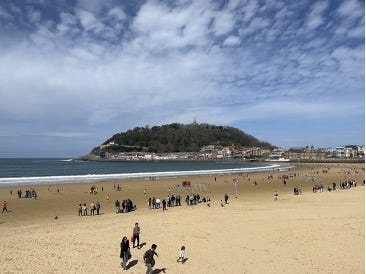5 Food Reasons to Visit San Sebastian (other than Michelin stars)
Fancy restaurants are wonderful, but there’s so much more.
We just returned from a week-long culinary tour in San Sebastian – a culinary tour that Oldways organized as part of our Culinaria series. I learned a lot, and one thing is for sure –San Sebastian is now one of my favorite cities!
If you love food, San Sebastian is for you. The city is famous for food, noted as a city with many Michelin-starred restaurants – 8 within the city and 16 within a 25-kilomter radius.
Fancy restaurants are wonderful, but there’s so much more. So, Michelin-starred restaurants aside, here are 5 really good reasons why you don’t want to miss San Sebastian!
1. Pintxos! Pintxos (PEEN-chos) are a small snack, like tapas, and they are integral to life in San Sebastian. People meet for pintxos at the end of a work day, and on weekends, the streets are teeming with friends and family meeting for pintxos. You may run into the mayor of San Sebastian, on his way, just leaving his favorite Pintxos bar. The deal is to have one pintxos, whether it be anchovies or squid or a tart or stuffed peppers, and one thing to drink (see more below) at each Pintxos bar you visit. Visit enough bars and you have yourself a full dinner and a fabulous evening!
2. Txakoli. The Basque region is known for Txakoli, a slightly sparkling, very dry wine that is a the perfect companion to Pintxos. Made primarily from a grape variety called Ondarrabi Zuri that is grown in an area around the town of Getaria, Txakoli is a young, fruity white wine with with a touch of fizz and a moderate alcohol content (9.5 to 11.5).
According to San Sebastian tourism, “30 years ago, txakoli was considered a vulgar drink, acidic, uninteresting. But now it is one of the great ambassadors of our cuisine. A white wine, sophisticated, with irresistible freshness which dazzles the most demanding of diners.”
We visited our favorite producer, Ameztoi, that invented the famous rose-style of Txakoli, and were charmed by the winery, the view and the spectacular Txakolis. It could become your new favorite summer drink!
3. Cider. If you’re not drinking txakoli while you’re pintxos hopping, there’s a good chance you’ll be enjoying a glass of Basque cider, a fermented apple drink. While it is also produced in nearby towns, San Sebastian is the cider capital of the region, due to its history around shipping. Cider was taken by sailors crossing the Atlantic because it was a safe alternative to water.
Cider Culture describes the process of making Basque cider: “Local cider houses (sagardotegi) make cider (sagardo) using local high-tannin, high-acid apple varieties, like Andoain, Gorri and Burgo. The juice is fermented using native yeasts, and it is aged in large chestnut casks or barrels; the resulting cider is sharp, dry and wild.”
Cider season in San Sebastian is January to April, which means we were lucky enough to experience it first-hand. We learned that cider is poured from a height, in order to aerate it (although I think the tradition has become as important as the aeration!). See my first attempt at pouring!
American producers have begun embracing Basque Cider – ask when you’re looking for a great new cider!
4. Cheese. Two of Spain’s best-known cheeses – Idiazabal and Roncal— are from the Basque region, and especially the province of Navarre. We had the pleasure of visiting Kamiku, a cheese producer in Navarre who gave the Oldways group what I call a “pinch-me day,” one of those days that you can’t believe how lucky you are to be where you are.
The company was started by a husband-and-wife team – a veterinary surgeon and an agricultural enginee— giving them a special connection to the animals, land and cheesemaking process. Kamiku’s artisanal production features five sheep milk cheeses, three from raw milk and two pasteurized. Particularly special are two hard cheeses from raw milk that have a creamy texture – one natural and one smoked – and an intense and strong Idiazabal Bertizarana PDO Cheese, made from raw milk from Latxa sheep from their own flock. If you can’t get to the Basque Region, we’ve been told that Formaggio Kitchen in Cambridge, Massachusetts carries Kamiku! We loved seeing all the animals and a lunch extraordinaire!
5. The Restaurant Scene and Gastronomic Societies. As Alan Richman, the well known, award-winning restaurant critic wrote in GQ in February 2006, “I have never believed there are places where all the food is good, any more than I believe there are places where….all the days are sunny, all the beaches are clean or all the winds blow true. Having been to San Sebastian, perhaps I should reconsider these disheartening convictions.”
While the number of Michelin-starred restaurants in and around San Sebastián is amazing, it is possible to eat simply, deliciously, and very well at any number of restaurants throughout San Sebastian – whether it be among the charming streets of the Old City or along the docks or beachside of La Concha or the new city. Also very interesting are the Gastronomic Societies, where originally men (and now women, too) gather to eat, cook, drink and play together. Make a friend in San Sebastian, and you’ll probably be invited to cook and eat in their Gastronomic Society. Fun!
And then, if you wish, because you’re there — go Michelin-stars!
PS. Be sure to visit (or stay) at the Maria Cristina Hotel. It’s the beautiful Grande Dame of San Sebastian. If you’re not staying there, stop in for a coffee or a drink!
New Trip Announcement! Join us in Parma & Emilia Romagna, Italy’s food region
April 7-14, 2024
Join us to experience spectacular Parma, Modena and Bologna through guided food, wine and cultural tours with guide Alice Rossi, cooking classes with Chef Michael Lombardi, and fabulous meals.
We’ll be staying in one hotel in Parma, within easy walking distance of the wonderful town of Parma, full of charm, great shopping, cultural sites and great restaurants. We’ll venture outside Parma to visit producers of Parmigiano Reggiano, Prosciutto di Parma, and Aceto Balsamico Tradizionale. We’ll learn about the wines of the region, and we’ll eat fabulously in neighborhood trattorias, country inns and classic city restaurants.
If you’ve always wanted to learn more about these three iconic foods, this is the trip for you!
Registered Dietitians can earn continuing education credits.











